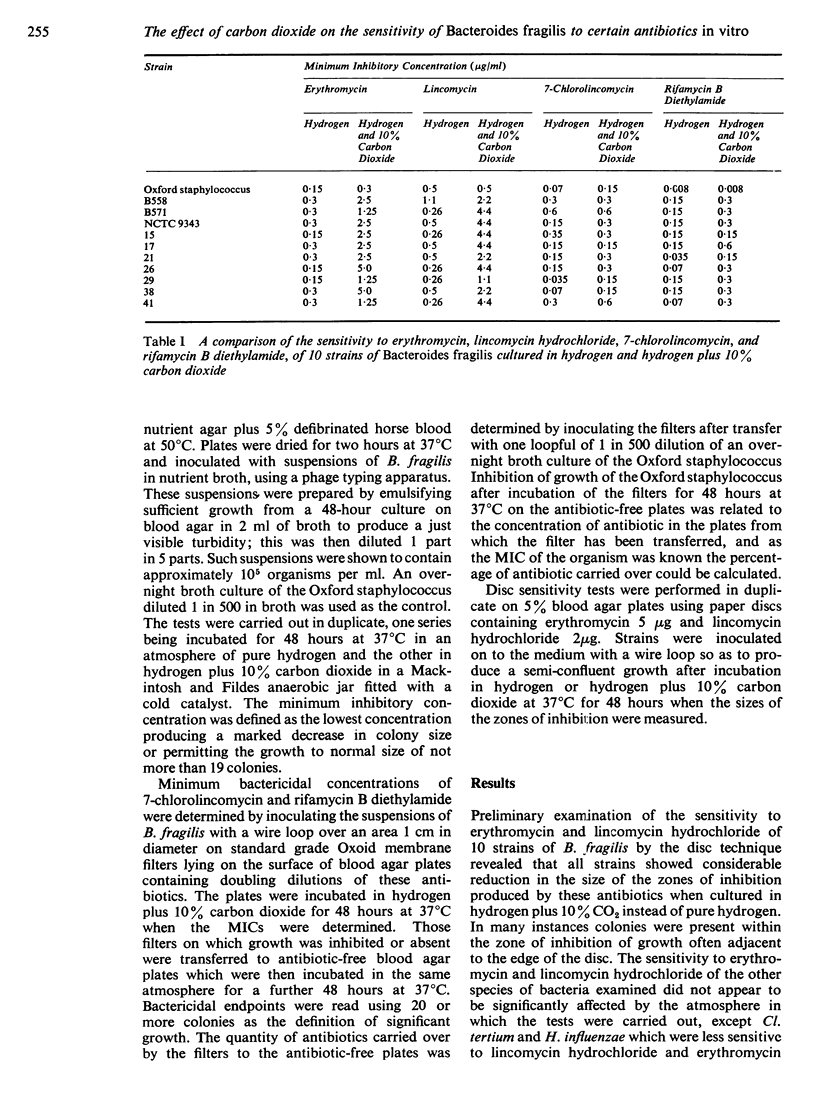Abstract
The effect of 10% carbon dioxide on the sensitivity to four antibiotics of 10 strains of Bacteroides fragilis was studied. The minimum inhibitory concentrations of erythromycin and lincomycin hydrochloride for these strains were four to 32 times higher, when grown in hydrogen plus 10% carbon dioxide, than the values obtained when the strains were grown in pure hydrogen. A similar effect was obtained by growing the strains in hydrogen on an acid medium. Except for Haemophilus influenzae and Clostridium tertium the sensitivity to erythromycin and lincomycin hydrochloride of other species of bacteria examined was not affected by the atmosphere in which the tests were carried out. 7-Chlorolincomycin and rifamycin B diethylamide, to which the strains of B. fragilis were uniformly sensitive, were not significantly affected by additional carbon dioxide.
The possible mechanisms underlying this phenomenon and its clinical implications are discussed, and a case report describing the successful use of erythromycin in the treatment of a cerebral abscess due to B. fragilis is presented.
In a recent study in this laboratory of the sensitivity to antibiotics of B. fragilis the majority of strains were found to be inhibited by 0·15 μg/ml of erythromycin and by 0·55 μg/ml of lincomycin hydrochloride (Ingham, Selkon, Codd, and Hale, 1968). After this work had been completed hydrogen plus 10% carbon dioxide was substituted for pure hydrogen in the anaerobic technique. Strains of B. fragilis isolated on routine culture now appeared to be relatively resistant to erythromycin and lincomycin hydrochloride when their sensitivity was examined by the disc diffusion method. A more detailed investigation of this phenomenon was carried out, the results of which are reported here. The opportunity was also taken to examine the susceptibility of B. fragilis to two new antibiotics, namely, 7-chlorolincomycin and rifamycin B diethylamide.
Full text
PDF




Selected References
These references are in PubMed. This may not be the complete list of references from this article.
- GARROD L. P. Sensitivity of four species of bacteroides to antibiotics. Br Med J. 1955 Dec 24;2(4955):1529–1531. doi: 10.1136/bmj.2.4955.1529. [DOI] [PMC free article] [PubMed] [Google Scholar]
- GARROD L. P., WATERWORTH P. M. Behaviour in vitro of some new antistaphylococcal antibiotics. Br Med J. 1956 Jul 14;2(4984):61–65. doi: 10.1136/bmj.2.4984.61. [DOI] [PMC free article] [PubMed] [Google Scholar]
- GILLESPIE W. A., GUY J. Bacteroides in intra-abdominal sepsis: their sensitivity to antibiotics. Lancet. 1956 Jun 30;270(6931):1039–1041. doi: 10.1016/s0140-6736(56)90802-9. [DOI] [PubMed] [Google Scholar]
- HAIGHT T. H., FINLAND M. The antibacterial action of erythromycin. Proc Soc Exp Biol Med. 1952 Oct;81(1):175–183. doi: 10.3181/00379727-81-19815. [DOI] [PubMed] [Google Scholar]
- Hoogendijk J. L. Resistance of some strains of Bacteroides to ampicillin, methicillin and cloxacillin. Antonie Van Leeuwenhoek. 1965;31(4):383–385. doi: 10.1007/BF02045917. [DOI] [PubMed] [Google Scholar]
- Ingham H. R., Selkon J. B., Codd A. A., Hale J. H. A study in vitro of the sensitivity to antibiotics of Bacteroides fragilis. J Clin Pathol. 1968 Jul;21(4):432–436. doi: 10.1136/jcp.21.4.432. [DOI] [PMC free article] [PubMed] [Google Scholar]
- Sabath L. D., Gerstein D. A., Loder P. B., Finland M. Excretion of erythromycin and its enhanced activity in urine against gram-negative bacilli with alkalinization. J Lab Clin Med. 1968 Dec;72(6):916–923. [PubMed] [Google Scholar]


